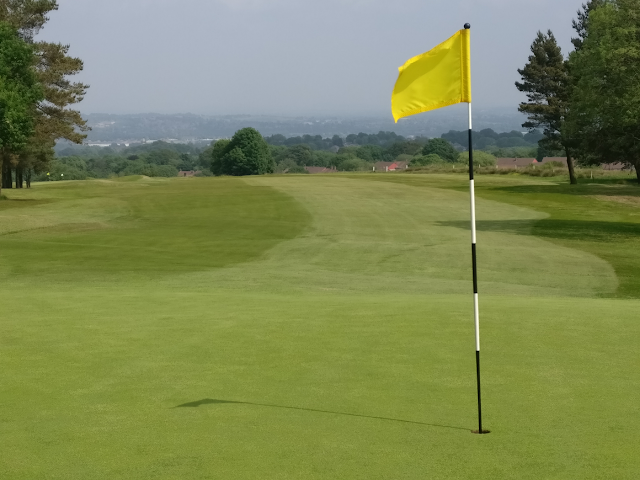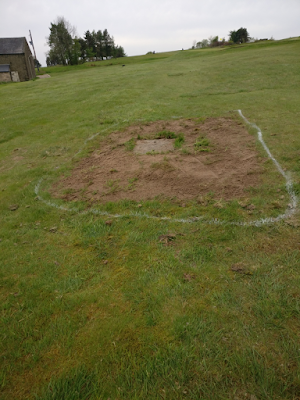Trees and Turf Quality
There has been a lot of debate
recently with regard to the use of trees on a golf course and recently an email
was sent out to all the members explaining some of the main reasons why trees are
sometimes removed.
The purpose of this blog is to explain in more detail what
effect trees have on the reduction in turf quality and give solutions to the problems. It is certainly not an instruction to take all the trees out on the course, it is simply some information to digest, that by carefully planning some work around the course, the quality of the holes could be improved if so desired.
Just to explain in full, trees
are a major cause of poor turf quality on many courses up and down the land.
There are four main areas where the negative impact of trees can be summarised,
and they are:
·
Shade
·
Poor Air Circulation
·
Tree Root Competition
·
Interfering limbs and branches
 |
| Shade can harm greens and tees, causing frost to stay longer and disease to form |
Shade
This is probably the biggest
cause of turf weakness on a golf course. If you combine shade with golf traffic
from buggies, trollies and machinery, the results can be very serious. The
grass plant needs light to photosynthesize and produce food to grow and
regenerate. When turf sits in shady conditions the food sources are depleted
and it becomes too weak to recover from traffic.
 |
| Shade on 14th green. As he sun comes higher and further round the shade cast by the trees develops all over the par 3. |
There is also plenty of evidence
to suggest that certain diseases, such as Fusarium, favour shady conditions
rather than out in the full sunshine. Greens and tees are very susceptible to
damage as they receive a lot of traffic condensed over a small area, but also
rough areas which receive a lot of traffic (on 5 and 14 for example) can also suffer.
 |
| Shade on the right of 5th. Another area of very poor quality turf |
The lack of direct sunlight on
any turf area also prolongs any potential drying out period after rainfall.
This leads to greater disease activity and increased soil compaction.
To overcome a shade problem, it
may be necessary to remove canopy and understory trees to increase the chance
of sunlight hitting those areas.
Poor Air Circulation
Another consequence of too many
trees in close proximity to important play areas is poor air circulation. In
areas such as greens and tees where air is poor, the temperature of the air is
usually higher, and usually little or no breeze is available in the area. Also,
soil temperature and soil moisture levels tend to remain higher for longer
periods due to the lack of good drying conditions.
As a result of these factors,
disease activity, heat stress and soil compaction effects are common in such
areas. As with shade, all these factors favour Poa annua taking over, a grass
species which always performs poorly during stress periods.
 |
| A typical example of damaged and fallen trees in the woodland |
The key to resolving problems
with air circulation is to open passageways for air to move through the area.
Removal of shrubs and understory trees can significantly improve the situation
while generally thinning the canopies can also be of benefit. Removal of larger
trees, especially those that block the prevailing winds, can prove very helpful
if smaller measures fail.
 |
| Allowing air to flow through to bottom of course, clearing out the dead or decaying trees |
Shade and air circulation
problems usually go together, but this is not always the case. For example,
some greens or tees may well receive full sunlight throughout the day, however
they may well be suffering from poor air movement. This is particularly true on
poorly drained soils, and large pockets of this golf course is built on heavy
clay. So, each problem area has to be looked into on its own merit.
 |
| Poor quality growth and lack of previous tree management programme |
Tree Root Competition
One of the main hidden (and
sometimes clearly visible) dangers of trees is the effect of their roots on the
turf nearby. Trees and turf both absorb water and nutrients through their roots
to live and grow. And like turf, the roots of trees are mainly active and
located in well aerated areas of the soil profile. In other words, turf roots
and trees roots can be in direct competition for any water and nutrients, and
usually it will be the turf that suffers during periods of weather stress.
 |
| Poor quality tree with visible tree roots |
A way to reduce or eliminate this
tree root competition is to mechanically prune the tree roots. This is normally
done around greens and tees, but larger scale areas could also benefit if the
need arises. There are various machines available to carry out this kind of
work and they can be hired in. It would be recommended to carry out this kind
of work every year or two and many golf courses have adopted root pruning as an
annual practise in those areas of need.
Interfering Limbs and Branches
Maybe you are wondering how
branches or parts of trees that interfere with a golf shot may cause problems
to the turf quality, but this is exactly what happens on tees. Trees planted
years ago, either next to a tee or down the fairway, can eventually grow to the
extent that their limbs interfere with a tee shot. (A perfect example of this
right now is the right hand side of the 15th tee)
When playing from the affected tee,
golfers compensate by teeing up on the opposite side of the tee. As a result
one side of the tee receives most of the wear and the other receives less and
less play. This can affect the playing quality of the tee. The side not used as
much can develop thatch problems and the overused side can become thin of grass
cover, weak and then dominated by inferior grass species.
 |
| 6th Tee clearing on the left and visible overhanging branches on the right |
Rather than trying to force
growth on the tee or spending extra time and resources on trying to improve
playing quality, tree work is the best solution in the long run.
Summary
Trees greatly affect the turf
quality on the golf course by the shade they cast, the air circulation they
block and the roots they produce. They can also reduce the useable area on a
tree by maybe 30-50% by producing limbs that interfere with play on a side (or
both sides) of the tee.
When planting trees on the
course, great care must be given to the planning of where the trees are to be
planted. For our established trees, a good programme of tree removal and branch
thinning would increase sunlight penetration and air circulation, and limbs can
be removed to allow the full use of tees. Root pruning should also be
considered for the future. It is very clear that although many trees were planted over the last 30 or 40 years, there has been no tree management in place for their future welfare. If there had been a 5, 10 and 15 year follow up regime, we probably would not be facing the issues we have now and the golf course would be better for it.
The effects of trees can cause
unwanted stress to turf which may be already suffering from traffic, extreme
weather and other issues. By carefully considering the above, it will hopefully
be possible to improve the health and playability of the turf, especially where
trees are an integral part of the area.

















































